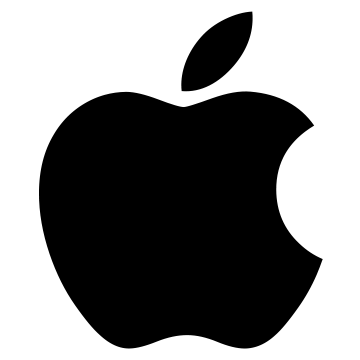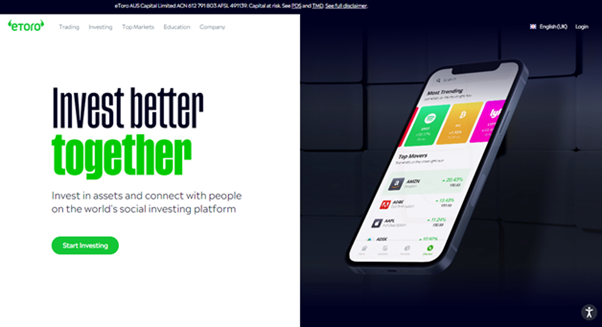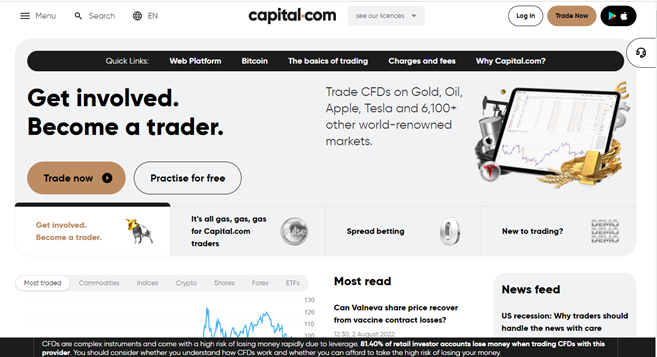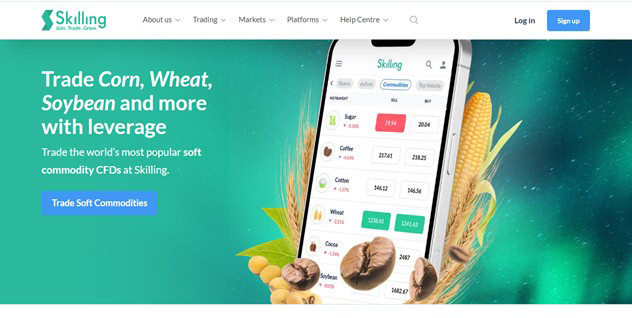How to buy Apple stocks in 2025

Apple is arguably one of the most innovative companies of the past decade, having grown from a phone and PC (Mac) maker to a colossus with interests in everything from electric cars to AI. Apple currently makes more profits from services than from iPhone sales, and it has grown its presence in digital wearable devices.
With each product launch, Apple has kept its fiercely loyal customers on edge as they anticipate the next breakthroughs and the next creative upgrades to their devices. This has made Apple one of the most valuable stocks in the US stock market. It is one of the few stocks that offer growth and value, which Warren Buffett refers to it as a “family jewel”.
This guide tells you how and why you might want to buy Apple stock.
How to Buy AAPL Stocks in 5 Easy Steps
-
1Visit eToro through the link below and sign up by entering your details in the required fields.
-
2Provide all your personal data and fill out a basic questionnaire for informational purposes.
-
3Click 'Deposit', choose your favourite payment method and follow the instructions to fund your account.
-
4Search for your favourite stock and see the main stats. Once you're ready to invest, click on 'Trade'.
-
5Enter the amount you want to invest and configure your trade to buy the stock.
The Best Reviewed Brokers to Buy Apple Shares
1. eToro
eToro was launched in 2007 and has since risen to be the most popular social trading platform with a user base of over 17 million worldwide. The platform makes trading accessible to anyone and anywhere by courting beginners and experts with its rich library of tools and resources. You can read our full eToro review here.
Security and Privacy
eToro is regulated by the Financial Conduct Authority (FCA) and the Cyprus Securities and Exchange Commission (CySEC) and has received its brokerage licenses to operate in Europe, USA, and Australia from several regulatory agencies.
eToro uses standard security features such as SSL encryption and 2FA, thereby protecting users' personal information and funds from a security breach.
Fees and Features
Firstly, eToro is a multi-asset platform, that is, users have access to more than 2,000 financial assets like stocks, ETFs, cryptocurrencies, indices, and more. Another great feature of eToro is the social trading feature which allows you to join and connect with a community of other traders worldwide to shape your trading decisions. The platform also has a CopyTrader feature that allows one to copy the trading strategies of more experienced traders. eToro also offers its users free insurance that protects them in case of insolvency or an event of misconduct.
eToro offers zero commission when you open a long, non-leveraged position on a stock or ETF. However, every withdrawal comes with a $5 fee. The platform also charges an inactivity fee of $10 every month if you don't trade for 12 months.
| Fee Type | Fee Amount |
| Commission Fee | 0% |
| Deposit Fee | £0 |
| Withdrawal Fee | £5 |
| Inactivity Fee | £10 (monthly) |
Pros
- Copy trading feature
- SSL encryption to protect users' information
- Trading is commission-free
Cons
- Limited customer service
2. Capital.com

Capital.com is a multi-asset asset broker launched in 2016. The platform now has over 500,000 registered users with more than $5 billion in volume traded. Capital.com is built to help trading decisions with its Patented AI trade bias detection system. You can read our full Capital.com review here.
Security and Privacy
Capital.com is licensed and regulated by top regulatory bodies such as FCA, ASIC, NBRB, FSA, and CySEC. Users' information is secured and encrypted by Transport Layer Security, and users' funds are stored in a separate account.
Fees & Features
The brokerage's users can access 6100+ market options with CFD trading. It also provides educational materials to make a better trader out of its users. Capital.com also offers educational materials to assist customers in making more informed decisions. Customers can speculate on upward and downward movements in over 3000 markets. In its mobile trading app, the broker offers an AI-powered tool that provides individualized trading insights by utilizing a detection algorithm to uncover various cognitive biases.
Unlike many platforms, Capital.com operates a free service with no hidden charges, and it upholds its transparent fee policy.
| Fee Type | Fee Amount |
| Commission Fee | 0% |
| Deposit Fee | None |
| Withdrawal Fee | None |
| Inactivity Fee | None |
Pros
- 24hrs email and chat support
- MetaTrader integration
- Commission-void trading
Cons
- Mostly limited to CFDs
3. Skilling

Skilling is a fast-growing multi-asset broker with awesome trading terms. At its inception in 2016, its main focus was on bond market investment, and since then, it has grown into creating a new model for the stock exchange. In addition, users can trade various financial assets, including CFDs, forex, and cryptocurrencies. You can read our full Skilling review here.
Security and Privacy
Skilling takes the privacy and security of its users' assets very seriously. All information entered into the platform is encrypted, and only authorized personnel can access the information. The platform also uses two-factor authentication to protect its users.
Skilling is regulated by the Cyprus Securities and Exchange Commission (CySEC) and the Financial Conduct Authority (FCA), which means customers can be assured about their assets' security.
Fees and Features
Skilling has four main platforms: Skilling Trader, Skilling cTrader, Skilling MetaTrader 4, and Skilling Copy. Skilling Trader is intended for traders of all skill levels and provides access to all trading analysis tools. Skilling cTrader, on the other hand, is designed for more experienced traders, focusing on order execution and charting capabilities. MetaTrader 4 is a forex and CFD trading platform with a highly customizable interface. Finally, Skilling Copy is a trading platform that allows members to follow or copy the trading strategies of seasoned traders for a fee.
Skilling charges no fees for inactivity, deposits, or withdrawals. However, commissions on FX pairs and Spot Metals are charged on Premium accounts. These fees begin at $30 per million USD traded.
| Fee Type | Fee Amount |
| Commission Fee | Varies |
| Deposit Fee | None |
| Withdrawal Fee | None |
| Inactivity Fee | None |
Pros
- Flexibility and ease of use
- Access to Forex, CFDs, among many others
- Excellent customer service
- Highly secured and well regulated
Cons
- Single currency operation
- Not accessible in the US and Canada.
Everything You Need To Know About Apple
Let’s look in more detail at Apple as a company: its history, business strategy, revenue generation, and financial performance for the past five years from 2021.
Apple History
Apple Computers, Inc. was founded on April 1, 1976, by Steve Jobs, Steve Wozniak, and Ronald Wayne (who drew the company’s first logo). After 12 days in the new venture, Wayne sold his shares back to Jobs and Wozniak for $800.
The company was incorporated as Apple Computer, Inc., in January 1977, and went public in 1980. In 1985, Wozniak departed Apple due to a diminishing interest in the day-to-day running of the company. Jobs also resigned to found NeXT, taking some Apple co-workers with him.
In the 1990s, Apple lost considerable market share to the cheaper Intel PCs that operate on Microsoft Windows. After the management failed to rehabilitate the financially troubled company and reshape its product, Jobs regained leadership status, becoming CEO in September 1997 after Apple acquired NeXT.
Apple swiftly returned to profitability following the successful launching of the iMac and iPod. The company expanded through the acquisition of numerous companies to broaden its software portfolio. It company was renamed Apple Inc. in 2007 to reflect its focus on consumer electronics. Apple launched the iPhone series to critical acclaim and financial success, and this has by far been the company’s most successful product.
What is Apple’s Strategy?
Apple’s business strategy is driven by broad product differentiation, vertical integration, and a customer-centric approach. By having a broad product portfolio, Apple has been able to expand its market share, enabling it to create new niches and reach new consumers. Apple has also been able to build an ecosystem around its products to make them work well together.
Vertical integration allows the company to design, develop, and manufacture its hardware and software in-house. In 2020, Apple announced that it would be manufacturing its M1 chips and would no longer be using Intel for its chip manufacturing. This reduces overhead expenses, allows for flexibility in design, and reduces supply chain issues that arise from using a third party for manufacturing.
In terms of customer relations and support, Apple has made it a point to focus on providing the best quality of service to its customers. Apple’s purpose-built stores provide support services such as repairs. They also allow new customers to experience Apple products before making the purchase. This increases the company’s brand loyalty.
How Does Apple Make Money?
For the 2020 fiscal year, Apple generated $274.5 billion in sales with $57.4 billion in net income, compared to $260.2 billion in sales and $55.3 billion in net income for fiscal 2019. This is the highest revenue the company has generated in a single year, and the impressive performance spilled over into 2021. The company posted a record quarterly revenue of $89.6 billion in Q1 2021, a 54% increase on a year-to-year basis.
iPhone continues to be the main revenue generator. The segment accounted for 44.26 percent of the company's overall revenue in 2020, and in the first quarter of 2021, this share increased to 58.9% or 66bn in sales for the company. The services segment is the second-largest and fastest-growing segment in the company.
By market size, the Americas is the company’s largest revenue generator. The region accounts for 52% of the company’s revenue. While the US is still the dominant market for Apple products, Asia is catching up due to a growing middle class with a taste for aspirational goods.
How Has Apple Performed in Recent Years?
In the five years to May 2021, Apple shares have appreciated by 461.73%. This implies that if you had invested $1000 in Apple stock around May 2016, your stock would have become worth $5,617.30. Between October and December 2018, the stock experienced one of its steepest falls when the Apple share price declined by over 30%. In March 2020, the stock experienced another steep fall when it lost 29.4% of its share price. However, the stock has since rallied by as much as 153% from its March lows, with an all-time high price (at the time of writing) of $145.09.
The post-earnings price movements, however, suggest that investors are growing doubtful of the company’s sustained dominance. Analysts are questioning if the company can continue to post record revenues and income.
This comes as Apple is embroiled in corporate spats with Facebook and some app developers. The company is also facing antitrust filings, and competition is increasing in the phone market.
These factors have put some pressure on the Apple stock which has traded flat for most of the year.
Where Can You Buy Apple Stock?
There are a couple of ways to purchase Apple stock. You can purchase Apple shares through a stockbroker after you have opened a brokerage account. However, make sure that the broker has access to the exchange (Nasdaq) where Apple stock is listed. Buying the shares through a broker makes you a shareholder of Apple. This means you are eligible for dividends and can vote on company matters. Note that Apple does not have a Direct Share Purchase Program (DSPP), so its shares can’t be purchased directly from the company.
If you just want to speculate on the price movement of Apple stock without getting ownership rights to the company, you can buy an Apple stock CFD from an online CFD broker but you must be aware of the dangers of leverage.
Apple Fundamental Analysis
Fundamental analysis is a method of evaluating an asset to know its true value and to make forecasts about its future price. A fundamental analyst reviews different factors that can affect a stock’s price, such as performance of the overall industry, government policy, trade policies and barriers, news and press releases, competitor analysis amongst others. This allows the analyst to reach a proper valuation of the stock and invest accordingly.
Fundamental analysts use certain financial ratios to analyze the value of a stock. These ratios include P/E ratio, revenue, earnings, earnings-per-share, dividend yield, and cash flow, as follows.
Apple’s Revenue
A company’s revenue refers to the total amount of money generated from services offered or goods sold. It is the money realized from the sale of goods and services within a given accounting period. Analysts refer to it as the "top line" because it is located at the top of the income statement.
You can usually find a company’s income statement on its corporate website. For the 2020 fiscal year, Apple generated $274.5 billion in sales (with $57.4 billion in net income) compared to $260.2 billion in sales (and $55.3 billion in net income) for the 2019 fiscal year.

Source: Yahoo Finance
Apple’s Earnings-per-Share
Earnings-per-share (EPS) is used by financial analysts and investors to weigh a company’s financial strength. It is considered to be one of the most important variables in determining the value of a stock. Many investors still look to EPS as a gauge of a company's profitability. EPS is calculated by dividing the company's profit by the outstanding shares of its common stock.
A higher EPS means a company made more profit for its shareholders. For 2020, Apple’s annual EPS was $3.28, a 10.44% increase from 2019. Apple EPS for the quarter ending March 31, 2021, was $1.40, a 118.75% increase year-over-year.
Apple’s P/E Ratio
The price-to-earnings ratio (P/E) is another metric widely used by fundamental analysts and investors to determine the value of a stock valuation. It is the relationship between a company’s stock price and its earnings per share (EPS). The P/E ratio gives investors a better sense of the value of the company, as it shows the expectations of the market and the price it is willing to pay for future earnings.
Generally, a high P/E suggests that a stock's price is high relative to earnings and may be overvalued. It indicates that investors are expecting higher earnings growth in the future, so they are willing to pay a higher share price today. Conversely, a low P/E might indicate that the current stock price is low relative to earnings and possibly undervalued. Growth stocks usually have a high P/E because investors are expecting higher future returns. This is unlike value stocks which have a lower p/e ratio because investors are not willing to pay a higher share price today for future earnings.
Apple's P/E ratio on 6 May 2021 was 28.75, which is fair for a tech company. However, the P/E doesn’t factor in the company’s earnings growth rate. The PEG ratio, which measures the relationship between the P/E ratio and earnings growth, may provide a more complete story than the P/E alone.
Apple’s Dividend Yield
The dividend yield is a financial ratio that measures the annual value of dividends a company pays relative to the share price of its stock. Dividend per share is the company’s total annual dividend payment, divided by the total number of shares outstanding. A company with a high dividend yield pays a substantial share of its profits in the form of dividends.
If you're a value investor or looking for dividend income, the dividend yield is an important metric to consider. Dividend yields are inversely related to the stock price. When the price of a stock rises, its dividend yield falls and vice versa, which is why the dividend yield of beaten-down stocks often looks unusually high.
The current trailing-twelve-months (TTM) dividend payout for Apple at 6 May 2021 was $0.82, making the dividend yield 0.64%.
Apple’s Cash Flow
Cash flow refers to the increase or decrease in the amount of cash a company has for its operations. It summarizes the amount of cash and cash equivalents entering and leaving a company.
In finance, the term is used to describe the amount of cash (currency) that is generated or consumed in a given period. The cash flow statement measures how well a company manages its cash position — how much cash it generates to pay its debt obligations and fund its operating expenses.
The cash flow statement complements the balance sheet and income statement. It helps investors to understand how a company's operations are running, where its money is coming from, and how money is being spent. It can help investors determine whether a company is on a solid financial footing. According to its latest earnings report, Apple has a trailing-twelve-month free cash flow of $90.47bn at the time of writing.
Why Buy Apple Stocks?
There are very few companies that can match Apple’s financial feats. The company continues to report growth in all its business segments. Apple has shown that a big company can continue to grow, expand, and create more niche markets. Since 2016, shares of Apple have produced an average three-month return of 3.5%. The company is also positioned to gain from the 5G revolution.
Here are some reasons for buying Apple stock:
- Apple is the world's most valuable company
- It is a trusted brand with an extensive product portfolio
- It is the market leader in innovation and digital products
- It has consistently increased dividends payments
- It has about $195 billion in cash reserves
Expert Tip on Buying Apple Stock
“ Apple is stock that you buy to own rather than actively trading it. Aim to buy on dips and accumulate shares over time. But beware of the main issues in 2021 — a global chip shortage, some recent spats with Facebook and app developers, and several antitrust filings — all of which seem to have given investors cold feet. ”- Emmanuel Ekwomadu
5 Things to Consider Before You Buy Apple Stock
Before investing in Apple, there are certain factors you might need to consider. The relevance of these factors varies among investors according to their investing knowledge, time, and capital. This section outlines five things you need to consider before buying Apple Stock.
1. Understand the Company
Legendary investors Warren Buffett and Peter Lynch are famous for telling investors to buy what they know. Buffett suggests investing in companies that you understand enough to explain how they make money (i.e., the company's business model). He advises investors to build a circle of competence and invest in stocks that fall within that circle. You are more likely to make informed decisions when you invest in what you know.
While buying what you know is certainly relevant, in terms of practical investing advice, familiarity is not enough. You need to study the company's balance sheet and overall financial direction to value the company properly.
2. Understand the Basics of Investing
The investment landscape can be extremely dynamic and fast-paced. Those who take the time to understand the basic principles stand to gain significantly over the long term. Understanding the basics of investing is similar to learning a new language. But once mastered, you will have a better understanding of how to invest your money and manage risks.
Risk management, investment portfolio diversification, fundamental analysis, using charts and technical tools, and knowing the basic evaluation metrics will take you a long way with investing.
3. Carefully Choose Your Broker
When it comes to deciding on a broker, there is no clear-cut choice, as your choice of broker will depend on many factors. Nonetheless, there are general things you should consider when deciding on a broker, and they include the ease of payment, security, access to the exchange, commissions, user experience, and support network. Some brokers require a minimum deposit before you can start using their trading platform, while others do not. Some have a higher bid-ask spread than others, while some may not offer options or margin trading. It is important that you clarify your investing style and goals first, before choosing the right broker for you.
4. Decide How Much You Want to Invest
Deciding the amount to invest depends on your investment goals, available capital, risk appetite, and how long you want to own the asset. The golden rule is never to invest what you can’t afford to lose.
It is much better to see investing as a form of savings rather than a business that offers stable cash flow for your livelihood. Most financial planners recommend investing between 10% and 15% of your annual income on long-term investment plans such as a pension.
5. Decide on a Goal for Your Investment
It is always appropriate to attach a goal for each of your investments, as it helps you to stay motivated. Perhaps you want to invest for your retirement or your kid’s tuition fees for college. Whatever it is, having a goal for your investment reminds you of why you put money into a stock and it helps you practice patience.
Also, you should have a strategy for achieving your goal. Your strategy determines when you buy and when you sell the stock.
The Bottom Line on Buying Apple Stocks
In summary, Apple should continue to play a leading role in the mobile phone and wearable technology markets. The company is also at the forefront of 5G technology adoption. As it continues to be innovative and create new niche markets, Apple will likely maintain its leadership position among tech companies. You can own Apple stock through a stockbroker.
To invest in Apple shares right now, all you need is to sign up for a stockbroker’s stock trading account, fund your account, select Apple from the categorized list of stocks, and place a market order or limit order to buy the stock.
If you think you’re not yet ready to invest right now, you can continue studying the company and reading our other guides like How the Stock Market Works, The Difference Between Fundamental and Technical Analysis, Market Psychology and a lot more on Buy Stocks.
Frequently Asked Questions
-
Apple shares can be purchased through any stockbroker that has access to the Nasdaq exchange. Apple does not have a direct share purchase program (DSPP) in place, so you cannot buy the stock directly from the company.
-
Apple could be a good stock to buy because It consistently pays increasing dividends. The company has a wide product portfolio and it implements vertical integration to reduce operating costs (and make more profits).
-
Apple has an electric car project codenamed "Titan", which has been ongoing since 2014. With its advanced software knowledge, the company is undoubtedly well-positioned to exploit the robotaxi market that will soon emerge.
-
Yes. Apple has been paying dividends to its shareholders since 2012. The company increases its dividend payments every year.
-
No, you cannot purchase Apple stocks directly. Apple does not have a direct share purchase program (DSPP).
-
Shares of Apple have returned 461.73% in the last five years. $1000 invested in Apple five years ago would be worth $5617.30, generating an investment profit of $4,617.30.






